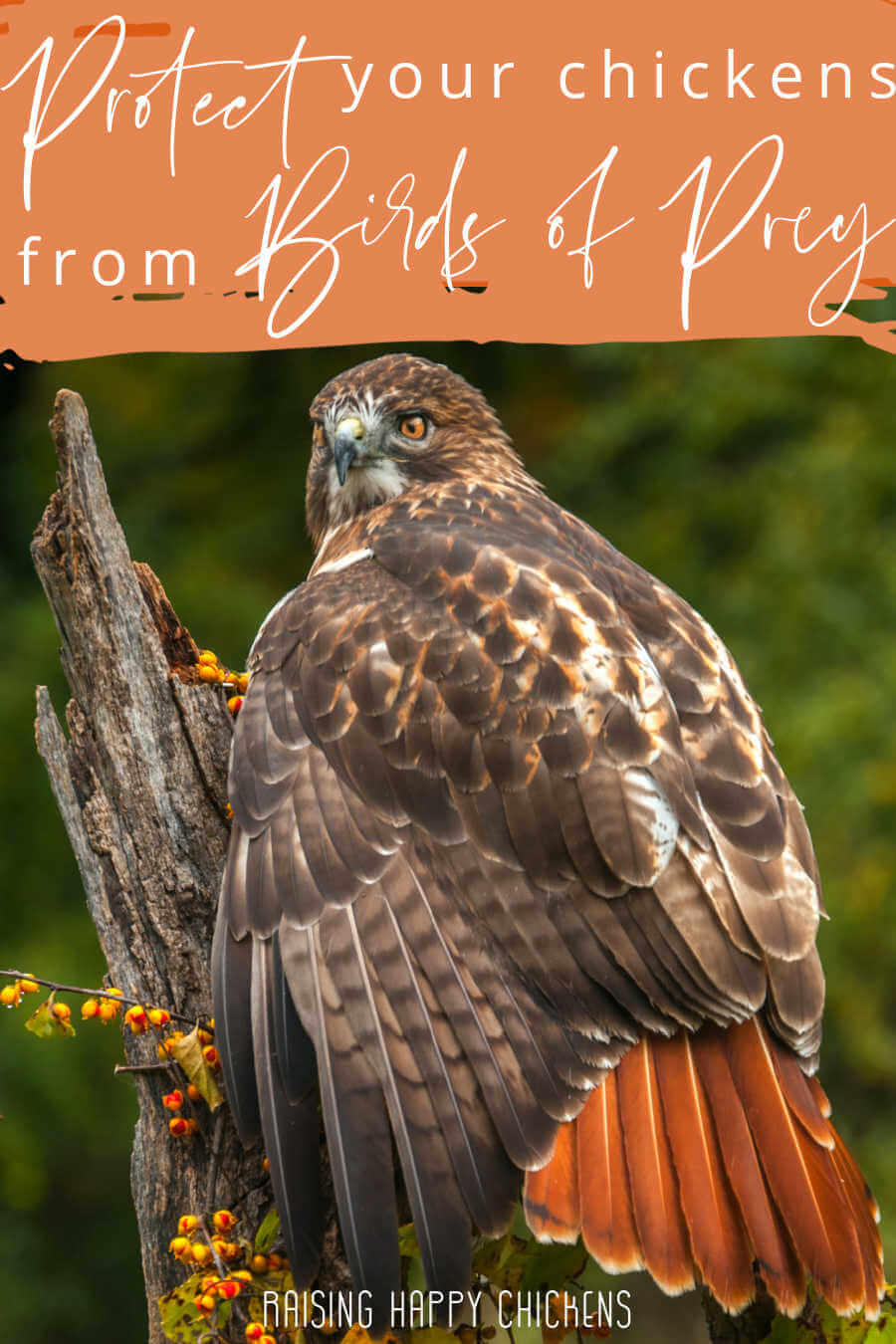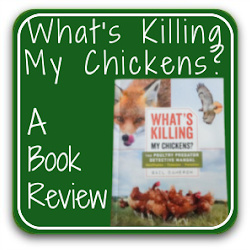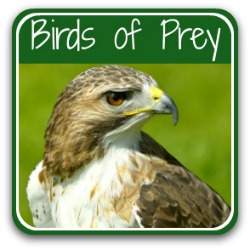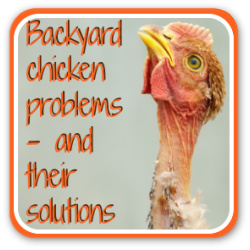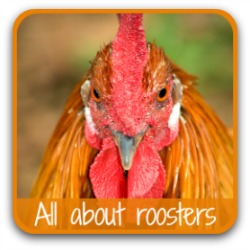How to protect chickens from birds of prey.
Problems with airborne predators? Here are ten ways to keep your flock safe you can implement now.
If you're having problems with your flock being attacked from the air, it can help to know which birds of prey you're dealing with.
For more information about that, take a look at my sister article, here. It details the types, their hunting habits and how to tell if you have them in your area.
This article concentrates on ways to make sure your chickens are protected as well as possible from these beautiful, but deadly, predators.
Some you'll be able to put into practice straight away, others may take more planning.
I include information about what has been proven to work, and make clear when the methods are more of a rural myth.
We'll start with the proven methods, and move into the less tried and tested after.
Important: birds of prey are protected by law.
No matter how understandably angry you may be at birds of prey taking your chickens, it's important to remember that they are protected by law, globally(1, 2).
Hunting, trapping, injuring, taking eggs from and disturbing nesting sites is against the law and carries a potential prison sentence.
So find ways of protecting your chickens that do not involve harming raptors!
1. Protect your chickens by covering the run.
Given that birds of prey always attack from on high - either from the sky or from a perch - covering at least part of your run is an obvious solution.
Some runs these days are already enclosed, in which case you're safe. The Omlet designs are a good example of this.
 A covered run like this one means your chickens are always protected, but have limited space.
A covered run like this one means your chickens are always protected, but have limited space.The cheapest way of covering a run is with chicken wire or netting, which has the advantage of being relatively inexpensive. It also allows your chickens to still see skyward.
The hope is that the birds, who generally have a highly refined sense of sight, will see the netting and leave for an easier mark.
The disadvantage is that the birds may simply become entangled and injure themselves. Avoid using any methods of protecting your chickens which involve causing harm to the birds.
A more expensive but equally easy and perhaps safer way is to buy a relatively heavy, strong tarpaulin like this one.
(Links like this are "affiliate links", which means that if you click and buy something, I earn a small commission at no extra cost to you)
It may seem expensive, but it has good strong grommets to hold it securely, and it's tear resistant so will last.
Its added advantage over wire is that it provides shade for your flock from both summer sun and winter rain and snow.
If your run is large, as mine is, cover just one corner of it. Your chickens will naturally shelter underneath it at any sign of danger.
2. Provide shade with trees and bushes.
Birds of prey are not able to negotiate through branches, so providing some trees in your run is another obvious way to prevent them swooping in.
I'm lucky enough to have massive bay, apple and fig trees, which not only provide shade and cover from predators, but give the flock some healthy treats in season.
And the area round the roots is always good for scratching out as a cool dust-bath.
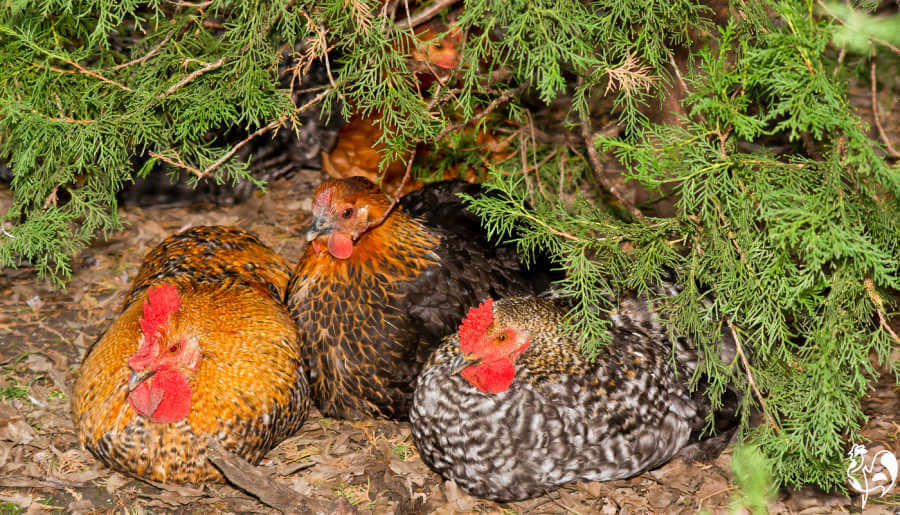 Fir trees are particularly good at providing shade, and a place to gather with friends!
Fir trees are particularly good at providing shade, and a place to gather with friends!It's also a good plan if your chickens free-range - make sure you have some trees and bushes dotted around your pasture rather than open land.
Small fruit trees will be fine. A row or two of bushes or brush also offers a place to hide underneath and may be less expensive than buying trees.
Take a look round your neighbourhood. If some of your neighbours have large bushes, ask whether you could have a root. If it's big enough, you could even split it in two.
A basket of eggs as a "thank you" is often all it takes.
3. Build a shelter to protect your chickens.
If you can't plant trees and bushes to provide shelter for your chickens to hide from birds of prey, make a simple shelter instead.
A couple of cement blocks or some bricks with a wooden pallet on top is all it takes. Alternatively, think creatively about what you have lying about the house which you no longer need...
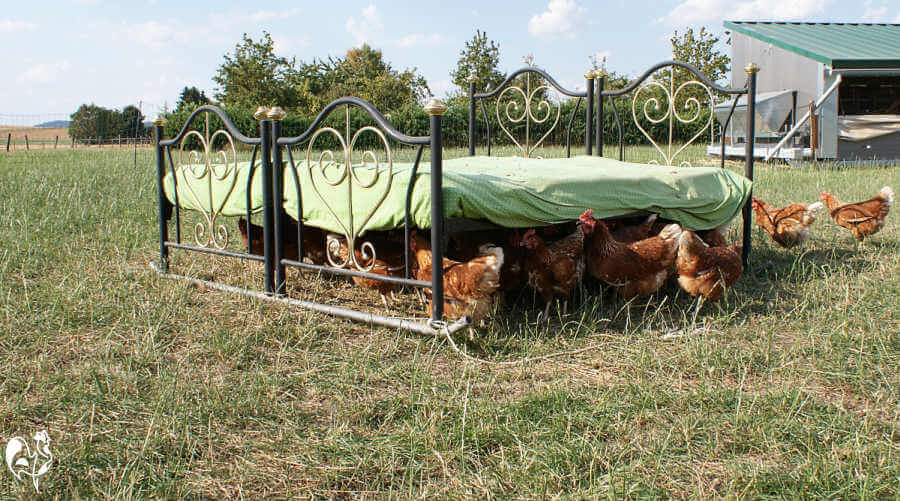 Be creative with your chicken shelters!
Be creative with your chicken shelters!4. Protect your feeders.
Chickens are particularly vulnerable when they're feeding. Heads lowered, guard down, often bunched together, they're a sitting target for all manner of predators, including birds of prey.
Hawks in particular are canny. They will learn where feeders are, and lie in wait.
So if your feeders and waterers are outside and not covered by the roof of a run, take action.
Build a covered shelter for the feeding station, or place the feeders against a wall. Birds of prey can't easily swoop close to solid objects - but check that they're not lying in wait at the top!
And of course, make sure you use a covered feeder which prevents any birds (not to mention rodents) looking on your chicken run as a fast-food outlet.
5. Get a rooster to protect the ladies.
It's a rooster's (UK cockerel's) job. A good roo will always be alert to any threat towards his flock. They have a highly honed sense of danger, and their first reaction will be to call the hens to a safe place.
If the attack continues, the rooster will make every attempt to fight off even a large bird of prey - and he will be prepared to fight to the death.
There are legal reasons why you may not be able to have a male in your flock, and there are other reasons why you may not want to.
But that apart, a rooster is a good addition to a flock in terms of predator control.
Not sure if it's possible for a rooster to win a fight with a hawk? Take a look at this cute video story. It ended happily, but it could have been so much worse - for the hawk!
6. The best dog to protect chickens: a Livestock Guardian Dog.
If you follow my Facebook page, you'll have seen stories about my Maremma Livestock Guardian Dog (LGD), Luce (meaning "Light", and pronounced "Loochay") and the more recent addition, Mara the Maremma pup in training (who is Luce's niece!).
Before Luce, two of my flocks were completely wiped out by predators - foxes and pine martens. Since Luce - not a single chicken has been lost. Not one.
Would an LGD fight off an attack from a bird of prey? Absolutely. And even a massive bird of prey like an eagle would stand no chance against 60 kilos (about 120lbs) of Maremma, protected as she is by thick fur round vulnerable areas like the neck and throat.
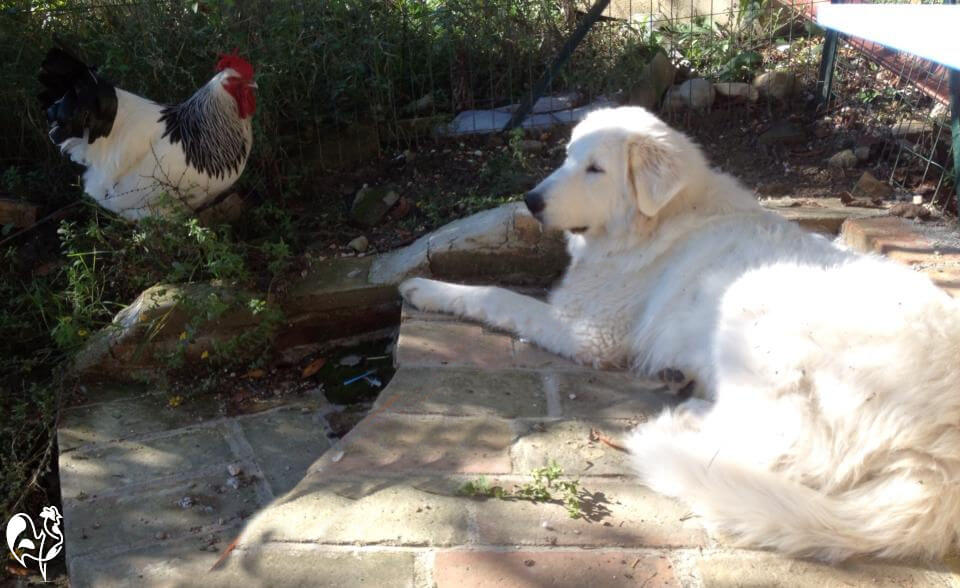 Luce - note the thick fur, especially around her neck and hind quarters.
Luce - note the thick fur, especially around her neck and hind quarters.Would a bird of prey even try? Doubtful. The scent of a dog is enough to keep all but the most desperate of raptors away.
Would another type of dog be able to ward off a bird of prey? Some certainly would. Would I ever trust another type of dog with my chickens? No.
An LGD has no prey instinct. They've been purposely bred that way, for a very long time. I was sceptical about that, until I saw Maremmas working in Italy, and then experienced Luce.
I know a lot of people will say their dog is great with their flock and would never hurt them. Until they do.
Your choice, of course.
7. Lock up your flock!
This is probably the most obvious solution, and it definitely works!
It's simple: make sure all your chickens are safely locked away in their coop at dusk and keep them there until it's fully light.
I know - sometimes, it's not that simple...
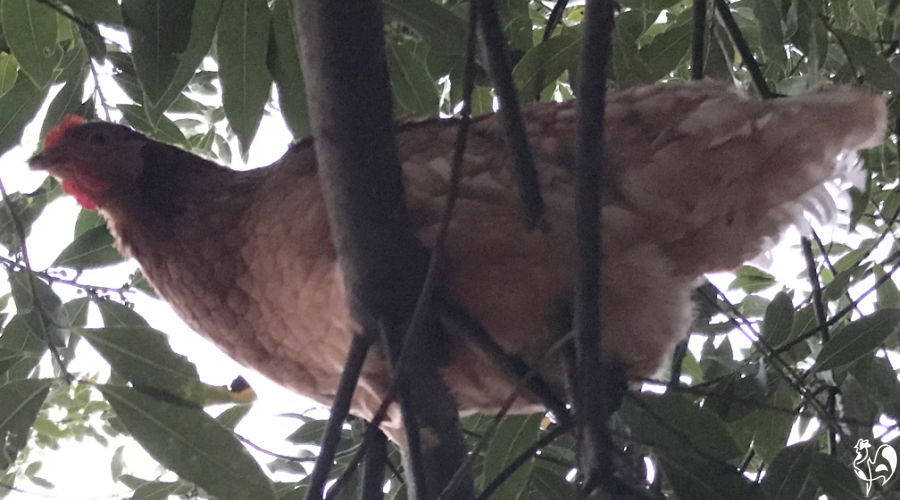 There's always one... Claudia prefers to roost 20 feet up in the bay tree.
There's always one... Claudia prefers to roost 20 feet up in the bay tree.Although hawks don't hunt at night, owls certainly do. And an owl is more than capable of carrying off a small chicken.
Why till daylight? Because owls don't need it to be completely dark to hunt. They can see perfectly well when light is less intense(3).
And remember that this doesn't only protect against raptors. Any coop should be completely predator-proof. Mammals like raccoons are only too adept at unlocking bolts.
We've looked at the deterrents that do work. Now let's review some that may. Or may not.
These options are not a first line of defence, but they may be helpful as a back-up.
8. Light as a deterrent for raptors.
Owls are night hunters, and lights at night may deter them. But not lights inside the coop - they will keep your chickens awake without doing anything to deter the owl.
So external lights are a possibility, and solar powered lights triggered by motion are ideal if you don't have electricity near the coop.
Hawks, of course, are day hunters, so night lights are irrelevant if hawks are attacking your chickens.
Some people swear by using light-reflecting items hanging from trees. Old CDs or DVDs are a particular favourite and, of course, great if you're on a budget.
A prettier alternative is something like these metal spinners.
Do they work? The jury's out. They're probably more likely to deter small birds from your vegetable plot. But if you're really troubled by hawks or crows, it may be worth a try.
Note: don't use mirrors. If they catch the sun there's a real possibility they will start a fire.
9. Will noise keep birds of prey away?
Radios, electronic and ultrasonic devices, even machines emitting sounds like explosions or gunshots. They're all available all over the internet, often at substantial cost.
Do they work? Highly unlikely - there are reports of even small garden birds actually nesting on top of them!
If you want to try using noise as a deterrent, buy yourself some nice wind chimes and hang them in your run. Personally, I prefer wooden chimes. My chickens were worried about them at first, but soon got used to them.
Did they deter hawks (we have buzzards and eagles around our valley)? Put it this way - I wouldn't swap them for our Livestock Guardian dog.
I use mine in a memory garden I created. It's my quiet place to remember family and pets, including chickens, who are no longer with me.
10. Decoys.
These are actually my favourite, mainly because there are so many fun versions available. But how effective are they as a way of protecting your chickens?
They're actually not bad. Like chickens, birds of prey tend not to like unfamiliar shapes. And because hawks and owls are natural enemies, they will avoid each other if they can.
So an owl decoy may deter hawks. And owls are territorial, so the sight of another (pretend!) owl in your run may deter another from prowling there.
You should be able to buy a simple owl decoy at your local feed store. If you're not, there are dozens available online.
This one is a favourite of mine because it doesn't just sit - its head rotates (TheOmen, anyone?!), it has bright red flashing eyes, and it emits a "frightening owlish sound"!
There are two issues about decoys.
Firstly, your chickens. They may well be more scared of it than their predators, and that can cause all kinds of issues, for example...
- egg-laying may stop
- the chickens may decide they don't want to be in the run
- if you have a rooster, he may become overly stressed by his responsibility to protect the hens from a predator he sees as taking no notice of his warnings.
Secondly, birds of prey are intelligent beings. They become used to sounds or objects quickly, so a decoy that stays in one place may be effective in the short-term but will lose its impact pretty quickly.
If you want to try a decoy, make sure you move it from place to place every few days.
So - what's the best way to protect your chickens from birds of prey?
Any of these methods is worth trying. Which is likely to work best depends on your individual situation.
For me, a combination of the first deterrents (Livestock Guardian Dog, trees and bushes, and protecting feeders) has meant that, although we have several very large raptors in our area - and they definitely keep an eye on the flock, circling high above the coop most days - we have never had any deaths by birds of prey.
What will work best for your flock?
Combinations are most effective. So take a look again at the options, and decide which will be the best for your environment, your budget and the kind of raptors you have around your chickens.
And always remember: you should protect your chickens without harming the birds of prey.
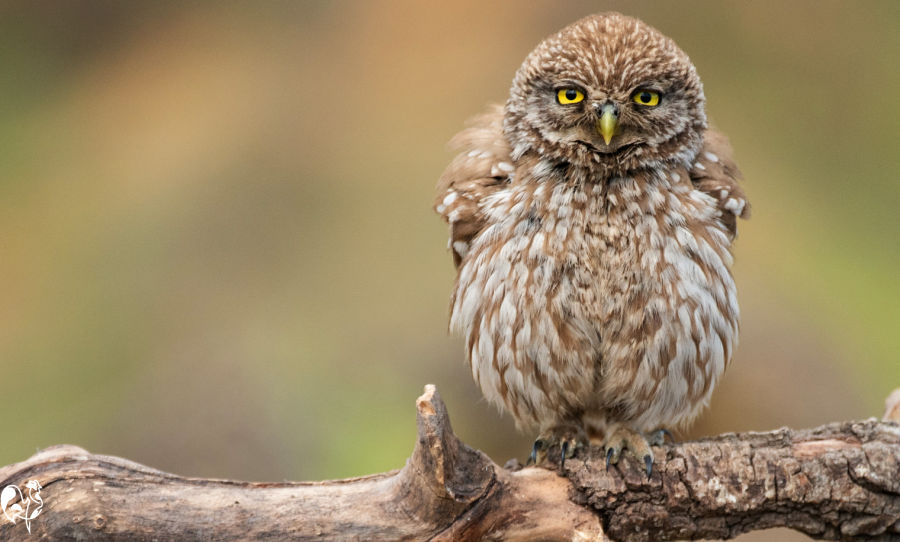
More articles you may find useful.
Sources.
1. Royal Society for the Prevention of Cruelty to Birds: UK charity. Information about punishments for harming birds of prey.
2. Migratory Bird Treaty Act: details of the US federal law protecting birds of prey.
4. Devokaitis, M: Seeing more hawks in your backyard? It's not your imagination! Pub. Cornelll Lab, 2019.
5. Damerow, Gail: What's Killing My Chickens? Pub. Storey, 2019.
